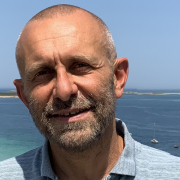The flat oyster,
Ostrea edulis, was once a very important species in France and especially on the coasts of Bretagne, where it provided a living for many fishing families. For several centuries, different fleets exploited these stocks without any real management measures. The many flourishing beds of the past disappeared from the 19th century onwards and aquaculture in the 20th century did not succeed in recovering production, even though it slowed the decline of the species in France. The flat oyster, which is 200 million years old, is now on the European list of species and habitats to be protected by OSPAR. It has totally disappeared from many areas in Europe. In France, we are still "lucky" to have small cryptic populations of flat oysters, mainly in Brittany and especially in the Rade de Brest. But for how long? These populations are extremely fragile and are not subject to any conservation or management measures.
But the problem behind this species and its overexploitation is even more complex: it is linked to the habitat that the specie is able to create. It is an engineering species, which builds (through its shell production) underwater mini-reefs that serve as supports and shelters for numerous other species (almost a hundred). A guarantee of biodiversity, these oases can also shelter species of interest to fishermen: scallops, cuttlefish and even abalone. During the plundering of the banks in the 19th century, an eminent scientist (Moebius, father of modern ecology), compared the habitat of the flat oyster to underwater forests to make the Government aware of the richness of these environments and the irreparable damage that was being done: the term "biocenosis" comes from his study of the flat oyster banks...
In this context, the FOREVER project (FEAMP project) was therefore interested, from 2017 to 2020, in the ecological status and health of the last populations present in Brittany and addressed the first aspects of the ecological restoration of the species. This pioneering project in France showed that it was possible to restore the species in a significant way by developing initial methods adapted to the environments where the species is still present. It echoed other restoration projects elsewhere among our European partners in the framework of the NORA Alliance. The final report of the FOREVER project has been available since 2021 and a new project, REEFOREST, has taken over in 2022.
Download the final report of the FOREVER project


 Arctic bloom
Scroll to top
Arctic bloom
Scroll to top